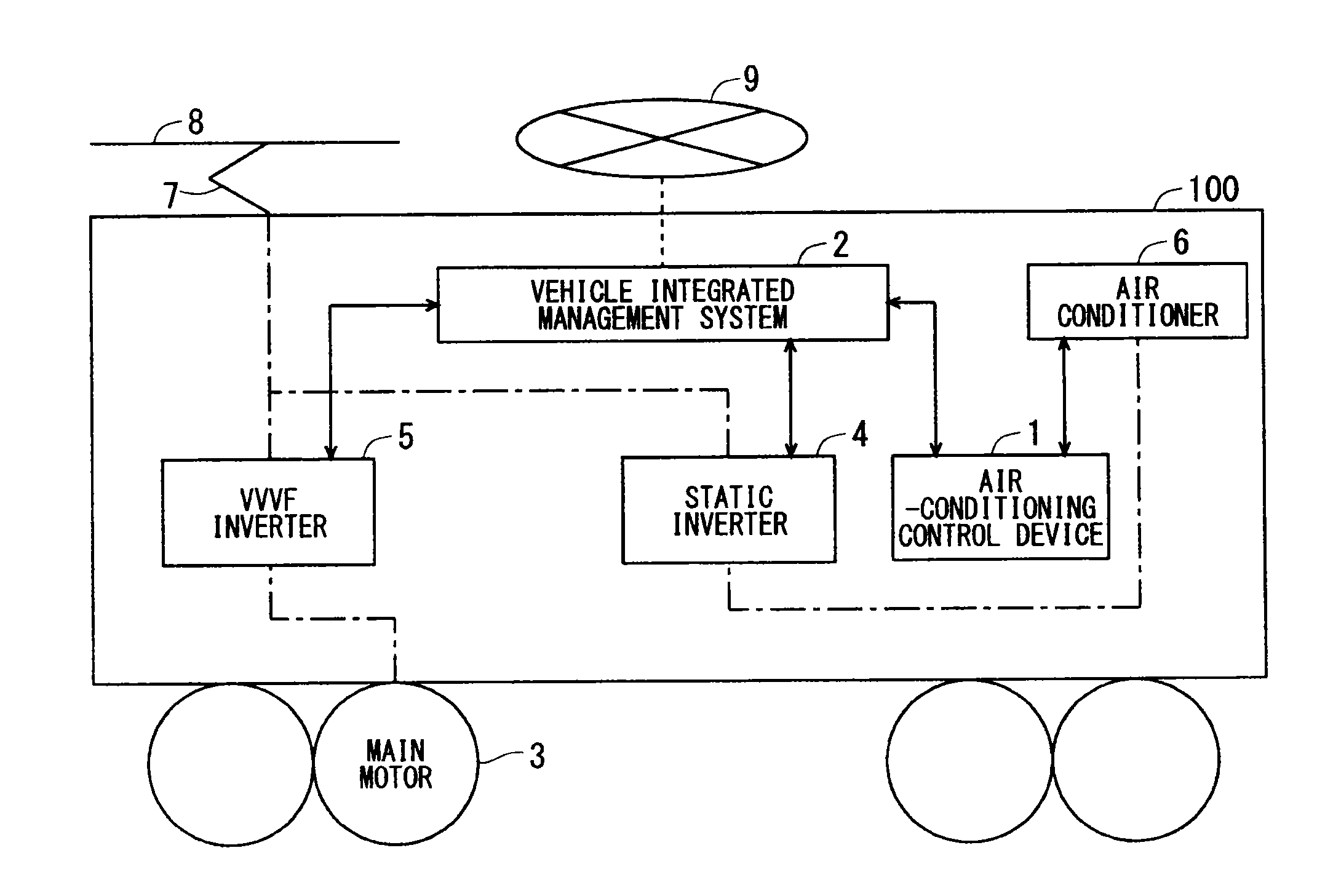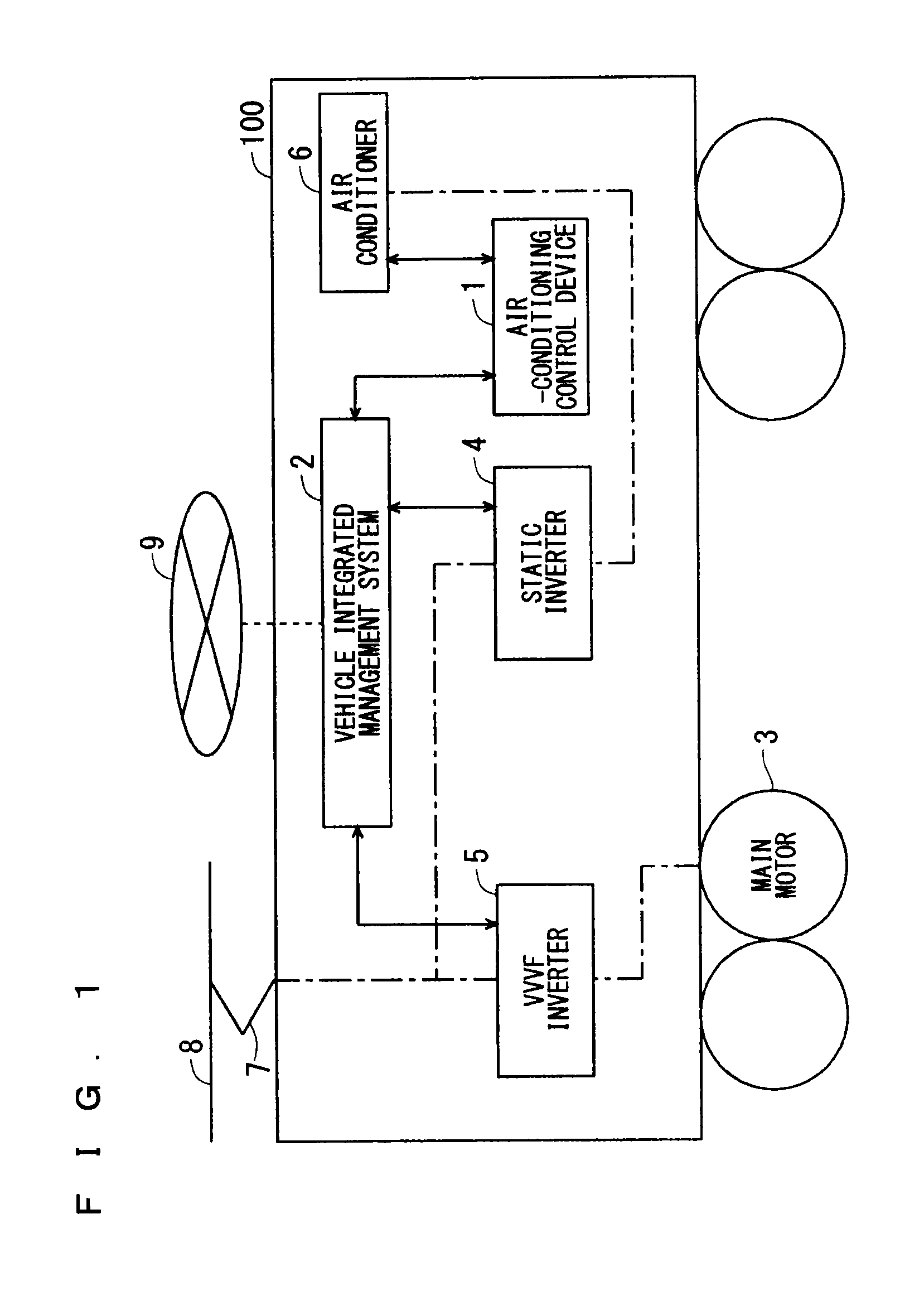Vehicle air conditioning control device
a control device and vehicle technology, applied in the direction of temperatue control, process and machine control, instruments, etc., can solve the problems of power saving, shortening the service life of the substation, and temporal loss of vehicle interior comfort, so as to achieve the effect of vehicle interior comfor
- Summary
- Abstract
- Description
- Claims
- Application Information
AI Technical Summary
Benefits of technology
Problems solved by technology
Method used
Image
Examples
embodiment 1
[0043]FIG. 1 is a block diagram showing a configuration of a vehicle 100 including a vehicle air conditioning control device 1 according to an embodiment 1 of the present invention. The vehicle 100 includes the vehicle air conditioning control device (hereinafter also referred to simply as “air conditioning control device”) 1, a vehicle integrated management system 2, a main motor 3, a static inverter 4, a variable voltage variable frequency (VVVF) inverter 5, an air conditioner 6, and a pantograph 7. In FIG. 1, the transmission and receipt of information is indicated by a solid arrow or a broken line and the transmission and receipt of electric power is indicated by alternate long and short dashed lines.
[0044]The vehicle integrated management system 2 integrally manages controls for the vehicle 100 including the motor control, the brake control, the door control, the air conditioning control, the lighting control, the in-train guide control, and the destination guide control. The v...
embodiment 2
[0113]FIG. 6 is a block diagram showing a configuration of an air conditioning control device 1A according to an embodiment 2 of the present invention. As the air conditioning control device 1A according to the present embodiment, the air conditioning control device 1 according to the embodiment 1 of the present invention that is shown in FIG. 2 described above further includes a feeding voltage detector 28. Similarly to the air conditioning control device 1 according to the embodiment 1, the air conditioning control device 1A according to the present embodiment is the vehicle air conditioning control device and is included in, for example, the vehicle 100 shown in FIG. 1 described above in place of the air conditioning control device 1 according to the embodiment 1. That is, the air conditioning control device 1A, which is included in the vehicle 100, controls the air conditioner 6 in the vehicle 100.
[0114]The following describes the differences between the configuration of the air...
embodiment 3
[0129]The embodiments 1 and 2 described above have referred to the air conditioning control devices 1 and 1A capable of performing the air conditioning control, in other words, the operation control with consideration given not only to the vehicle interior comfort but also to the energy saving and the power saving. An embodiment 3 of the present invention refers to the air conditioning control device capable of creating an air conditioning operation plan including the predictions on the changes in the vehicle interior temperature and the vehicle interior humidity after the air conditioning control and of grasping, in advance, the vehicle interior comfort, the energy saving, and the power saving.
[0130]FIG. 9 is a block diagram showing a configuration of an air conditioning control device 1B according to the embodiment 3 of the present invention. Similarly to the air conditioning control devices 1 and 1A according to the embodiments 1 and 2, the air conditioning control device 1B acco...
PUM
 Login to View More
Login to View More Abstract
Description
Claims
Application Information
 Login to View More
Login to View More - R&D
- Intellectual Property
- Life Sciences
- Materials
- Tech Scout
- Unparalleled Data Quality
- Higher Quality Content
- 60% Fewer Hallucinations
Browse by: Latest US Patents, China's latest patents, Technical Efficacy Thesaurus, Application Domain, Technology Topic, Popular Technical Reports.
© 2025 PatSnap. All rights reserved.Legal|Privacy policy|Modern Slavery Act Transparency Statement|Sitemap|About US| Contact US: help@patsnap.com



